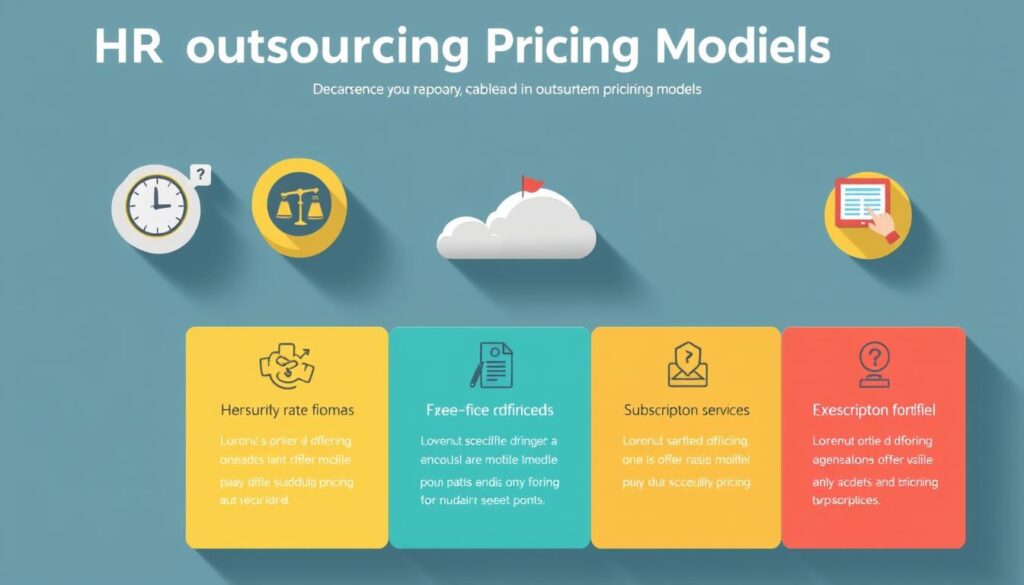In today’s fast-paced business world, many companies are turning to HR outsourcing. This move helps them save money, work more efficiently, and focus on what they do best. But, figuring out the cost of HR outsourcing can be tricky. This guide will help you understand the different costs, pricing models, and how to get the best value for your money.

Key Takeaways
- Learn about the key HR tasks that can be outsourced and how they help your business grow.
- Find out about the different pricing models for HR outsourcing, like per-employee-per-month and full-service plans.
- See what affects HR outsourcing costs, like the size of your company, what services you need, and where you are located.
- Compare the costs and benefits of Professional Employer Organization (PEO) services versus traditional HR outsourcing.
- Discover ways to negotiate better HR outsourcing deals and get the most value for your investment.
Understanding HR Outsourcing: An Overview of Services and Benefits
In today’s fast-paced business world, HR outsourcing is a key strategy for companies. It lets them work with HR outsourcing services to get better at managing their people. This partnership brings in the skills and tools of outside HR experts, offering many benefits for growth and success.
Core HR Functions That Can Be Outsourced
HR outsourcing covers a wide range of services. This means businesses can pick what they need most. Some main HR tasks that can be outsourced are:
- Payroll processing and administration
- Employee benefits management
- Compliance and regulatory reporting
- Talent acquisition and recruitment
- Performance management and employee development
- HR information system (HRIS) implementation and maintenance
Benefits of HR Outsourcing for Business Growth
Using external HR management brings many benefits for growth and success:
- Cost Savings: Outsourcing HR cuts down on costs, freeing up money for other important investments.
- Improved Efficiency: Outsourcing HR lets companies focus on their main work while handling HR tasks.
- Access to Expertise: Outsourced HR teams bring deep knowledge, ensuring the company follows best practices and stays compliant.
- Enhanced Employee Experience: Outsourced HR can make the workplace better, leading to happier, more productive employees.
Strategic Advantages of External HR Management
HR outsourcing also offers long-term benefits:
- Scalability: Outsourced HR can grow with the company, keeping HR support in line with business needs.
- Risk Mitigation: Outsourced HR handles complex rules and laws, protecting the company from HR-related risks.
- Innovation and Transformation: Outsourced HR brings in new ideas and technologies, helping the company improve and change.
Understanding HR outsourcing services and their benefits helps businesses make smart choices. This can lead to better HR management and more opportunities for growth and success.
How Much Does It Cost to Outsource HR: Breaking Down the Numbers
Finding out how much it costs to outsource HR can be tricky. It depends on many things. But knowing the average prices for HR services and what affects these costs can help businesses make smart choices.
The HR outsourcing costs can range from simple tasks like payroll to full HR management. Basic services like payroll and compliance usually cost between $5 to $15 per employee per month. More detailed services, like handling benefits and talent management, can cost between $15 to $50 per employee per month.
| HR Service | Average Cost (per employee per month) |
|---|---|
| Payroll and Compliance | $5 – $15 |
| Benefits Administration | $10 – $25 |
| Talent Management | $15 – $35 |
| Full-Service HR Outsourcing | $15 – $50 |
The exact HR outsourcing costs a business pays can change based on several things. The size of the company, the services needed, and where the provider is located all play a role. Bigger companies might get better deals, while those with more complex HR needs could pay more. Also, the cost of living in the provider’s area can affect the HR service pricing.
Understanding the different HR outsourcing costs and what influences them can help businesses plan better. They can budget for HR outsourcing that fits their goals and budget.
Factors That Influence HR Outsourcing Pricing Models
Several key factors can affect HR outsourcing costs. Knowing these can help you find the best deal for your business.
Company Size and Employee Count Impact
The size of your company and how many employees you have matter a lot. The more employees, the more you can save by outsourcing HR. This is because HR pricing factors like payroll and benefits can be handled more efficiently with a bigger team.
Service Level Requirements
The level of service you need from your HR provider also affects the cost. If you need advanced services like strategic consulting, you’ll likely pay more. This is compared to those with simpler HR needs.
Geographic Location Considerations
Where your business is located and where the provider is based can also change the cost. Things like labor costs and taxes in different areas can impact the price you pay.
| Pricing Factor | Impact on HR Outsourcing Costs |
|---|---|
| Company Size and Employee Count | Larger employee base typically leads to higher potential cost savings |
| Service Level Requirements | More comprehensive services result in higher outsourcing costs |
| Geographic Location | Regional factors, such as labor costs and cost of living, can influence pricing |
Understanding these HR pricing factors helps businesses make better choices. This way, they can get the most value from their HR outsourcing contracts.
Common HR Outsourcing Pricing Structures and Models
Businesses have many pricing options for HR outsourcing. Knowing these can help you pick the right one for your needs and budget. Let’s look at some common HR outsourcing pricing structures and models.
Fixed-Fee Pricing
This model has a set fee for all HR services. You’ll know exactly how much you’ll pay each month or year. This makes budgeting for HR easier.
Per-Employee-Per-Month (PEPM) Pricing
The fee here depends on how many employees you have. The rate can change based on the HR service packages and outsourcing fee structures from the provider.
Tiered Pricing
Tiered pricing has different HR pricing models for various service levels or employee numbers. As your business grows, you can upgrade your HR services and adjust the cost.
“The right pricing structure can make all the difference in maximizing the ROI of your HR outsourcing investment.”
When looking at HR outsourcing, think about your business’s unique needs and size. Knowing the pricing options helps you choose the best fit for your HR service packages and business goals.

Per-Employee-Per-Month (PEPM) Pricing Explained
HR outsourcing often uses the Per-Employee-Per-Month (PEPM) pricing model. This model lets businesses pay a set rate for each employee. It’s a flexible and easy-to-predict option.
PEPM Rate Ranges and What They Include
PEPM rates change based on company size and services. They usually range from $30 to $150 per employee per month. This cost covers many HR tasks, like payroll, benefits, and compliance.
Additional Fees and Hidden Costs
Even with a clear PEPM rate, watch out for extra fees. These can include charges for extra services or fees for changes in employee numbers.
Calculating Total PEPM Costs
To understand total PEPM costs, consider a few things:
- Base PEPM rate
- Number of employees
- Additional services or features needed
- Setup, implementation, or per-transaction fees
By looking at these factors, companies can better understand the cost of HR outsourcing with PEPM.
Full-Service HR Outsourcing Costs vs. À La Carte Services
Businesses face two main choices in HR outsourcing: full-service HR and à la carte services. Knowing the costs and benefits of each can help you choose the right fit for your company’s needs and budget.
Full-Service HR Outsourcing: Comprehensive Support
Full-service HR outsourcing providers handle everything from payroll to employee relations. This makes HR management easier and provides a team of experts. But, it usually costs more than à la carte services.
À La Carte HR Services: Customized Solutions
À la carte HR services are great for businesses with specific needs or a tight budget. You can choose services like payroll or benefits and only pay for what you use. It’s more affordable but might need more management from your team.
| Feature | Full-Service HR Outsourcing | À La Carte HR Services |
|---|---|---|
| Scope of Services | Comprehensive HR support, including all core functions | Customizable selection of HR services |
| Pricing Structure | Higher overall costs, typically per-employee-per-month (PEPM) | Lower costs, with pricing based on specific services needed |
| Management Responsibility | Outsourced HR team handles most day-to-day tasks | Requires more internal HR management and oversight |
| Scalability | Easily scales with business growth | May require adjustments as business needs change |
The choice between full-service HR outsourcing and à la carte services depends on your company’s needs, budget, and HR skills. By weighing the options, you can find the best HR solution for your business’s growth and success.

Comparing PEO Costs with Traditional HR Outsourcing
Businesses have two main choices for HR management: Professional Employer Organization (PEO) services or traditional HR outsourcing. It’s important to understand the costs and benefits of each. This helps businesses choose what fits their needs and budget best.
PEO Pricing Structures
PEOs charge a per-employee-per-month (PEPM) fee. This fee can be between $50 to $150 or more. It depends on the company size and services needed. This fee covers many HR services like payroll, benefits, compliance, and training.
Cost-Benefit Analysis of PEO vs. Traditional Outsourcing
PEO services might seem pricier at first compared to traditional HR outsourcing. But, they often offer better value for many businesses. PEOs can get group health insurance and other benefits at lower rates. This can help balance out the PEPM fee.
PEOs also provide a wide range of services. This can make HR work more efficient and save on costs. It also helps with compliance, which can save money in the long run.
| Metric | PEO | Traditional HR Outsourcing |
|---|---|---|
| Pricing Structure | PEPM | À la carte |
| Service Scope | Comprehensive HR management | Specific HR functions |
| Cost Savings | Can lower overhead and improve efficiency | Dependent on specific services outsourced |
| Compliance | Shared responsibility with PEO | Sole responsibility of the business |
Choosing between a PEO and traditional HR outsourcing depends on the business’s needs and budget. Both options have benefits. The best choice will depend on the business’s specific situation.
ROI and Cost Savings from HR Outsourcing
Outsourcing HR can bring big benefits to businesses. By working with an HR outsourcing company, companies can work better, avoid legal issues, and get expert HR help. This all helps save money on HR costs.
One key advantage is saving on labor costs. By not having an in-house HR team, companies can cut down on expenses. HR outsourcing firms also get better deals on services, which saves even more money.
Also, outsourcing HR makes operations more efficient. Companies can focus on what they do best and grow. This leads to more productivity and profit.
| Benefit | Potential Impact |
|---|---|
| Reduced Labor Costs | Up to 30% reduction in HR-related labor expenses |
| Improved Compliance | Mitigate risk of penalties and fines by up to 75% |
| Enhanced Productivity | Increase employee productivity by up to 20% |
Working with a good HR outsourcing firm can bring many benefits. Companies can save money and work more efficiently. This leads to better performance and profits.
“Outsourcing HR functions allowed us to focus on our core business while maintaining compliance and delivering a superior employee experience.”
Tips for Negotiating HR Outsourcing Contracts
When you outsource HR, it’s key to get a contract that fits your business needs. Look over the contract terms, service level agreements, and price escalation clauses. This way, you can make sure the deal is good for you and clear.
Contract Terms and Duration
Think carefully about the contract length. Weigh the benefits of a long-term deal against the need for flexibility. Talk about termination clauses, notice periods, and penalties for ending the contract early. This helps you understand your duties and choices.
Service Level Agreements
Make sure service level agreements (SLAs) are clear. They should outline what’s expected, how fast, and the quality of service. The SLAs should match your HR needs. Include rules for service credits or penalties if the provider doesn’t meet standards.
Price Escalation Clauses
Examine the price escalation clauses closely. Know when the provider can raise their rates. Try to limit annual rate increases and ask for clear reasons for any price changes. This could include new laws or the provider’s costs going up.
FAQ
What are the core HR functions that can be outsourced?
You can outsource HR tasks like payroll, benefits, and compliance. Also, onboarding, training, and managing HR data can be outsourced.
What are the benefits of HR outsourcing for business growth?
Outsourcing HR gives businesses access to specialized skills. It also helps with compliance and reduces administrative work. This leads to better growth and profits.
What are the strategic advantages of external HR management?
Outsourcing HR lets businesses focus on what they do best. It helps them grow and use the latest HR technologies.
How do company size and employee count impact HR outsourcing costs?
Bigger companies with more employees usually pay more for HR outsourcing. But, they might get a better deal per employee because of economies of scale.
What service level requirements can affect HR outsourcing pricing?
The level of service needed can change the cost. This includes how fast you need responses and if you need customized reports.
How does geographic location affect HR outsourcing costs?
Where you are and where the HR provider is can change the price. This is because of labor costs, laws, and infrastructure in different places.
What is the Per-Employee-Per-Month (PEPM) pricing model for HR outsourcing?
PEPM pricing is based on a set rate per employee per month. This rate usually includes basic HR services, with extra fees for more services.
What additional fees or hidden costs should be considered in PEPM pricing?
Look out for extra fees for things like onboarding new employees. Also, there might be costs for advanced HR software or premium support. Always check the contract for all costs.
How can businesses calculate the total PEPM costs for HR outsourcing?
To figure out total costs, multiply the PEPM rate by the number of employees. Add any extra fees for special services. This gives a clear picture of the total cost.
What are the key differences between full-service HR outsourcing and à la carte services?
Full-service HR outsourcing covers everything at a higher cost. À la carte services let you choose what you need, often at a lower cost.
How do the costs of using a Professional Employer Organization (PEO) compare to traditional HR outsourcing?
PEOs charge a percentage of payroll, which can save money. But, businesses should weigh the benefits against the costs of using a PEO.
What are the potential ROI and cost savings from HR outsourcing?
Outsourcing HR can make businesses more efficient and reduce risks. It also gives access to specialized skills, leading to savings and a good return on investment.
What are some key considerations for negotiating HR outsourcing contracts?
When negotiating contracts, consider the terms, service levels, and price increases. Also, think about how you can customize services to fit your business needs.



